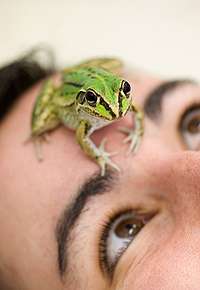Frog muscles survive big sleep

A rare Australian frog that burrows underground for a summer siesta resurfaces more than nine months later in just as good a shape as before its rest, according to UQ research.
Long hibernations usually waste mammal and amphibian muscles, but the green-striped burrowing frog is an exception.
UQ PhD student and zoology research assistant Beth Symonds has shown this frog's muscles were unaffected during its subterranean break to avoid the summer sun and dehydration.
Miss Symonds found that muscle contraction speed slowed slightly but the frog retained its power, muscle mass and muscle fibres after waking.
“If you immobilized a person for nine months they wouldn't even be able to walk,” Miss Symonds said.
The 29-year-old from Birkdale is now collecting data on three enzymes in the frog's muscle tissue to understand how it preserves energy.
She said it would take more research to explain exactly how the green-striped burrowing frog maintained its muscles after the big sleep.
She also believes that Australia's other burrowing frogs, of which there are more than 13 different species, were probably capable of the same feat.
Source: University of Queensland


















